COSTS
The cost of installing a solar system can vary widely and is affected by a range of factors from where you live, the retailer or installer you choose, the warranties available, and the technology and size of your system.
The major factors which will affect the price of a solar system are:
1. Government rebates and incentives
2. Contractor installation costs
3. Type and number of panels
4. Type and size of inverter
5. Type of framing equipment and other system components
6. Height and accessibility of roof and whether it is tiled or metal or concrete
7. Any after sales service agreements
Keeping the above variables in mind, these tables provide an approximate guide on the price range for solar systems in Australia’s major capital cities. Government rebates are included in these figures. Please note that the market costs change quickly so these numbers are illustrative only.
Estimated prices for residential solar systems
| SYSTEM SIZE |
ESTIMATED PRICE RANGE
(Out of Pocket) |
| 2 kW |
$2,800 – $5,600 |
| 3 kW |
$2,900 – $6,950 |
| 4 kW |
$3,400 – $7,900 |
| 5 kW |
$3,500 – $9,500 |
| 10 kW |
$7,600 – $14,100 |
SAVINGS
There are numerous factors that affect your suitability for solar and the period it will take for your system to pay for itself.
The amount of money your household will save on power bills by going solar is affected by several factors, including:
Your energy consumption and the size of your solar power system – if you use more power than your system can produce, your savings will be reduced. It’s important to choose the correct system for your needs.
Your feed-in tariff – this is the amount your electricity retailer pays you for any excess power your solar panels generate.
Your usage patterns – solar panels can only generate electricity while the sun is shining. This means that households that use a lot of power during the day may attract greater savings than those that consume most of their power at night. However, you will still receive a feed-in tariff for any excess electricity you generate during the day.
Where you live – some areas of Australia receive a lot more sunlight than others, so a solar system in Brisbane will usually generate more power than one in Hobart.

